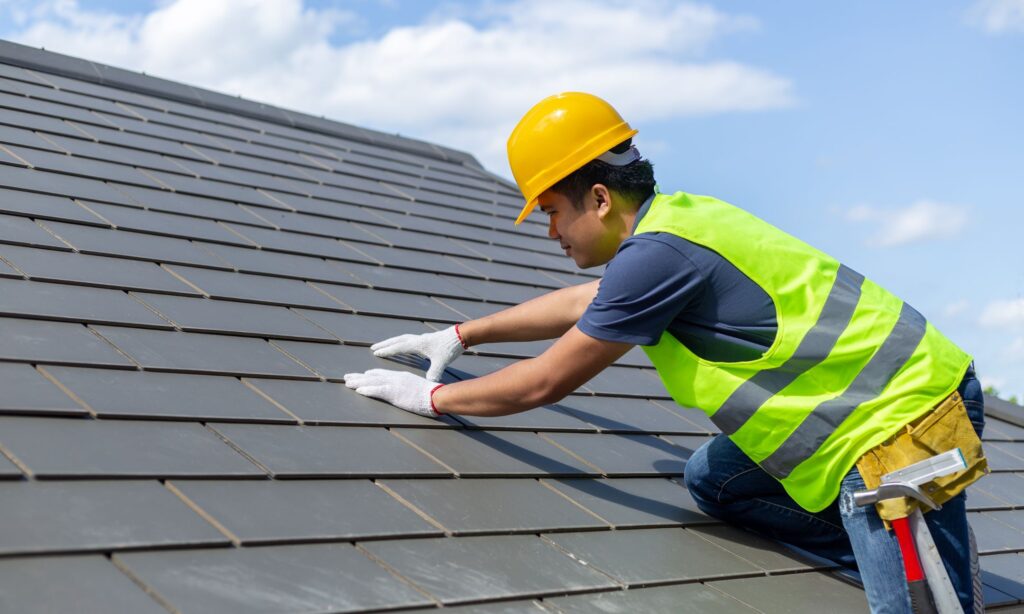As a homeowner, keeping your roof in good condition is essential to protecting your most valuable asset. However, roofs naturally sustain wear and tear over time from weather, age, and other factors. At some point, you’ll likely face the question of whether your roof just needs minor repairs or if complete replacement is necessary. This guide examines key signs of roof damage, considerations in deciding between repair and replacement, common repair scenarios, and when to opt for a new roof install.
Inspecting Your Roof – Interior Warning Signs

The first step is a thorough inspection inside and outside to identify any issues. Start in the attic and interior rooms beneath the roof. Look for these common interior warning signs of problems:
Dark Ceiling Streaks
Dark lines or stains on ceilings often indicate roof leaks allowing moisture intrusion that enables mold growth. Even small leaks can gradually ruin insulation, drywall, and framing if unchecked. Have the attic and roof decking inspected to pinpoint the source of moisture and determine if repairs or full replacement are needed.
Visible Light Through Ceiling
Seeing daylight shining through your ceiling means holes, cracks, or missing shingles/tiles are allowing exterior light penetration. This requires prompt roof repair to prevent further water damage, mold growth, and even potential collapsed ceilings if deteriorated areas continue widening from age and storms.
Sagging Drywall or Wood Paneling
Sagging or uneven ceilings indicate potential structural issues requiring further evaluation. Weight from water accumulation can compromise roof integrity over time, causing ceiling distortion and eventual collapse without remediation. Combining interior repairs with roof replacement often best solves chronic sagging related to water-damaged framing.
Signs of Water Damage
Actively leaking water, recent water stains, or soaked insulation suggest active roof deficiencies allowing elements inside even if not presently storming. Don’t ignore signs of water damage which likely indicate the need for prompt roof repair or restoration to prevent further destruction and hazardous mold colonies.
READ ALSO: Questions to Ask Before Hiring a Bathroom Remodeling Contractor
Checking the Roof Exterior
After fully inspecting interior spaces under the roofline, climb a sturdy ladder or hire a roofer to examine all exterior roof surfaces for these potential deficiencies:
Damaged, Cracked, or Missing Shingles
Look for any compromised, absent, or distorted shingles/tiles which no longer lie flat or have intact corners/edges. Curled, broken, or lost shingles cannot properly withstand weather and enable leaks over time. Have damaged areas patched or undertake full tear-off and roof replacement depending on age and extent of wear.
Gutters Filled With Shingle Granules/Debris
Finding lots of eroded shingle grit or tile pieces clogging your gutters signals advanced deterioration allowing elements into the roof decking and attic. Consider full roof replacement instead of repeating repairs which likely won’t fix fundamental weaknesses from age and environmental damage.
Extensive Algae, Moss, or Mold Growth
While some superficial organic growth on shady roof sections is normal, heavy moss, mold, or black streaks warrant remediation. First thoroughly clean the roof with bleach solution then improve attic ventilation to combat excessive moisture supporting growth. Significant fungus, algae, or mold growth can corrode shingles and sheathing to spur leaks.
Standing Water or Inadequate Drainage
Flat roof sections, low spots, and blocked gutters/drainage all enable hazardous water pooling. This leads to eventual roof leaks plus accelerated deterioration from moisture saturation and added weight burdening structural integrity. Ensure proper slope, flow to drains, and gutter/downspout function or replace failing waterproof membranes to restore drainage.
Loose, Separated Flashing Around Penetrations
Inspect where chimneys, vents, and skylights meet the roof. Gaps or lifting flashing allows moisture intrusion into vulnerable transition joints. Re-adhere, caulk, and seal any separated metal flashing then monitor for further looseness which indicates poor adhesion or issues with the underlying roof requiring replacement.
Extensive Hail Damage or Wind-Compromised Areas
After intense storms, thoroughly check for signs of hail impacts including dents, cracks, and granule loss over large regions. Likewise, note roof portions lifted by high winds or where decking got exposed or torn. Extensive storm damage often exceeds simple repairs and requires insurance claims and full roof replacement to reliably seal out the elements.
25+ Years Old
While today’s architectural shingle roofs can last 20-30 years through normal wear, be extra vigilant once your roof hits 25+ years to catch any developing leaks early. Expect to replace the entire roof soon to avoid worsening cracks and deterioration that open the door to moisture issues.
Key Considerations in the Repair vs Replace Decision
If you discover roof deficiencies through inspection, consider these key factors when deciding whether minor repairs or wholesale replacement work best:
Roof Age
How old is your existing roof? As materials like asphalt shingles near the end of their lifespan at 20-25 years, repairs become less effective and problems recur. Compare roof age to manufacturer warranties when determining next actions.
Repair Scope and Cost
Assess whether isolated issues like a few damaged shingles are more affordable to repair than completely re-roofing. But realize repair expenses add up over time and become less viable for aging roofs.
Extent of Damage
Repairs better suit limited concentrated issues versus widespread deterioration and granule loss. Examine what percentage of roof area needs work. Major damage to large sections likely merits replacement.
Expected Remaining Home Ownership
Are you moving soon? Selling shortly may warrant just patching isolated problems if the roof still protects from elements. But buyers notice quality and remaining lifespan, favoring newer roofs.
Budget Limitations
Lack of funds to replace an entire deteriorating roof may force staying with repairs temporarily if damage remains minor. Compare quotes for both options along with expected repair recurrence.
Aesthetic Concerns
Do mismatched shingle colors from repairs bother your home’s curb appeal? Roof replacements utilize consistent new materials for enhanced aesthetics and resale value.
When Should I Repair My Roof?
In certain situations, roof repairs make more economic sense than costly full replacements. Consider repairs in these common scenarios:
Isolated Storm Damage
If wind tore off a few shingles or hail dented a small section, repairs often suffice to seal deficiencies and prevent leaks. Evaluate age, match colors, and monitor for new issues.
Temporary Leak Patching
Locate and quickly patch sources of new moisture intrusion through flashing repairs, sealing damaged shingles, or improving drainage to satisfy immediate needs if replacement lies years away.
Recently Installed Roof with Minor Issues
Brand new roofs sometimes need adjustments to stop subtle leaks from improper sealing or flashing details. Touch up failing spots.
Selling Soon With No Major Problems
To boost resale value, repair any obvious exterior flaws or isolated interior damage for less than replacement if the majority of roof life remains.
Tight Budget But Roof Still Functional
Postpone wholesale replacement if funds don’t permit by carefully repairing bigger issues affecting roof integrity, functionality, and lifespan. But expect to replace once repaired areas show additional failures.
When Should I Replace My Entire Roof?
In many situations, extensive roof damage and age mean repairs no longer make practical sense vs. replacement. Consider full tear-off and re-roofing when facing these scenarios:
Frequent Repairs Needed
Repeated repairs over a short period indicate systemic deterioration issues across the whole roof that new materials will better resolve.
Major Storm Damage
If intense weather rips up or cracks over 30% of the roof area, insurance will likely require full replacement vs. patching because extensive repairs fail over time.
Leaks Persist After Multiple Repairs
Chronic moisture penetration even after sealing identified problem areas means fundamental roof failure. Repairs then only offer temporary relief from incurable leakage.
Roof Exceeds 20-25 Years Old
As common asphalt shingles near the end of their functional lifespan at this age, replacement avoids continual repairs and unpredictable failure.
Remodeling Whole House
Integrate fresh roof replacement into whole-home remodels for enhanced curb appeal and resale value since buyers expect updates.
Sagging Roof Sheathing
Major dips, divots, and distortion compromise structural soundness and indicate the need for tear-off to inspect and replace weakened roof decking.
READ ALSO: Bathroom Mold 101: Causes, Health Effects, and Removal Tips
To Recap
Evaluating whether your roof requires minor fixes or wholesale replacement hinges on careful inspection to identify and assess damage. While repairs better suit isolated issues on newer roofs, extensive deterioration and chronic leakage mean roof replacement often proves the wiser long-term investment for homeowners. Factoring in key considerations like age, problem scope, budgets, and homeowner plans aids the repair vs replace decision. Address all deficiencies promptly, even if just patching temporarily, to protect your most valuable asset – your home.
Frequently Asked Questions on Roof Repairs vs. Replacement
How much does roof repair cost compared to full replacement?
Typical asphalt shingle roof repairs like sealing flashing gaps, patching holes, replacing a few damaged shingles, or isolated repairs run $200-500. But costs scale up for extensive repair areas. Whole roof tear-off and installations often run $6,000-12,000, making major issues equally or less expensive to fully replace.
What are signs my roof near the end of its lifespan?
Indications your roof nears replacement time include advanced age (20-25+ years); recurring leaks and repairs needed; buckling, missing, cracked, or curling shingles; sections of roof deck visible under torn shingles; heavy algae/moss growth; and excessive granule grit loss exposing vulnerable asphalt shingle cores.
Should I repair hail or storm damage or replace the entire roof?
Have damage assessed to determine if localized repairs work or full insurance claim and re-roof better protect from the elements long-term. If over 30% of the roof suffered harm or if you wanted upgraded materials anyway, take the opportunity to replace the whole roof.
How long do roof repairs last compared to new roof replacement?
Repairs properly done on younger roofs may gain a few good years before issues resurface. But performance depends on the roof’s preexisting condition. Once fundamental breakdown begins from age, repairs last 6 months to 3 years before similar leakage and damage recur that require additional repairs. New roof installations last 20-30 years under normal circumstances. Weigh costs of repeated repairs vs. replacement.
In another related article, Avoiding the 5 Biggest Mistakes of Bathroom Remodeling





